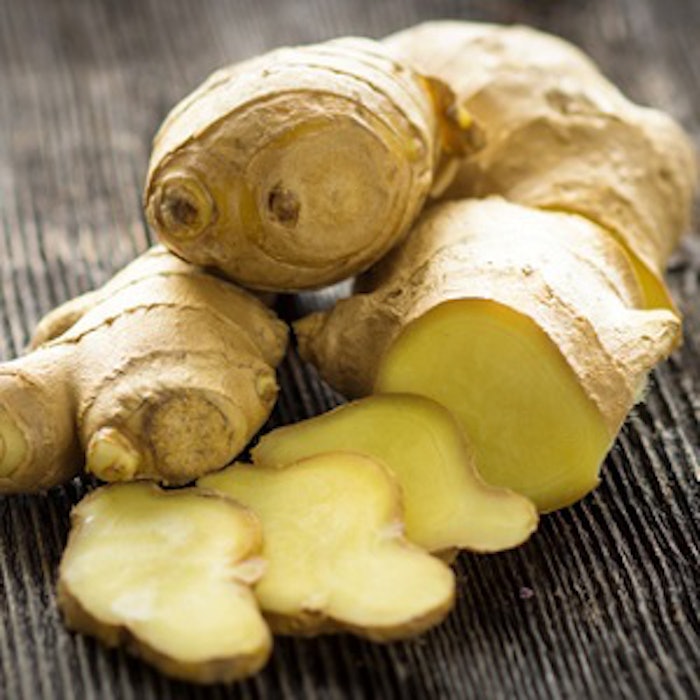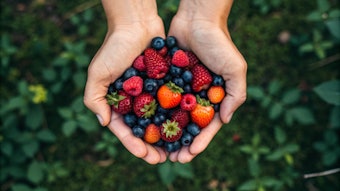
Ginger is one of the world’s most popular spices. Its usage is wide and varied, ranging from a culinary flavoring for both sweet and savory foods and beverages to a medicinal agent for numerous ailments. Here, Daemmon Reeve of Treatt plc examines the origins, cultivation and usage of this odd, knobby plant* and reviews its role as an essential oil for the flavor and fragrance industry.
Back to Its Roots
Ginger, Zingiber officinale, originates from southeastern Asia, notably southern China and India. In Roman times, dried powdered ginger was exported from India to Europe. After the fall of the Roman Empire, Arab merchants controlled the trade in ginger. And by the 13th and 14th centuries, along with black pepper, it was one of the most important spices for trading. At this time, in England, ginger was a sought after ingredient, with 1 lb in weight costing the equivalent to a sheep!
Today, ginger is grown throughout tropical and sub-tropical regions as it needs a humid climate with a heavy rainy season (minimum annual rainfall of 60 inches) and a hot dry season (temperatures of 90°F or over). China remains a key growing region. Jiangsu was a key province for ginger oil production 20 ago. However, this has now shifted to the Shandong and Anhui provinces where the land and climate are more suitable. This area is currently responsible for 90% of China’s ginger manufacture.
Growing Ginger
Ginger is a rhizome, a thick, horizontal underground stem that grows from root, not seed. A small piece of root with a growth spur is typically selected for planting in May, 6 inches deep. This plant sends up green, leafy stalks each spring. These stalks grow to between 12 and 40 inches in height and end in a spike from which small yellow-green flowers grow. The flowers are aromatic, but it is the rhizome that is the most useful part of the plant.
The gnarled rhizomes are harvested in November, at which point the entire root is lifted. From 22 lb of root planted, there is usually a ten-fold increase in weight on harvest. Due to the cold winter climate, the root cannot be dried in the ensuing months. A proportion of the root is sold at this time to spice dealers. The remaining root is stored in underground (10 ft deep) earthpits in Anhui and covered with soil. In Shandong, the biggest producing province in China, the root is stored in 32 ft deep pits supported by concrete cylinders. In March/April of the following year, the root is retrieved from this underground storage and graded. The good quality root is selected for the fresh spice market or for replanting. Any root not suitable for selling as dried root is processed into oil.
The Versatile Spice
Ginger is used in many different forms across the world:
- Fresh ginger: Fresh ginger (minced, crushed, grated, sliced or chopped) is an essential flavoring ingredient for many Asian dishes. It imparts a fresh, peppery flavor and spicy aroma. Once cooked, fresh ginger is less pungent and provides a milder flavor. Fried ginger is used in both Chinese and Indian cookery, for example in stir-fries and curries.
- Pickled ginger: Pickled ginger is also a popular accompaniment in Eastern cuisine. In Japan, for instance, pickled ginger is known as "gari" and "beni shoga" and eaten with sushi.
- Dry ginger: In the West, the more aromatic and less pungent dried form is traditionally most common. It is mainly used in baked goods, such as ginger snaps and gingerbread, puddings, preserves and drinks, including ginger ale and ginger beer: two refreshing, non-alcoholic soft drinks popular in the United States and United Kingdom, respectively. As ethnic foods become increasingly popular, fresh ginger is now readily available in Europe and America.
- Preserved ginger: Preserved ginger, often known as stem ginger, is another form of the spice. It is generally added to cakes and puddings, but sometimes eaten on its own as a spicy treat, as is crystallized ginger.
One Plant, Many Benefits
The use of ginger for medicinal purposes has been prevalent for centuries, particularly in China where it is one of the most widely used palliative. It is prescribed to treat numerous illnesses such as arthritis, migraine and sore throats. In the West, some people also use ginger as an herbal remedy to aid digestion and alleviate the symptoms of nausea and travel sickness.
Essential Ingredients
Ginger contains an oleoresin (gingerin) which imparts its refreshing, pungent yet warm taste. The plant’s sweet, citrus aroma comes from the presence of between 1 to 3% essential oil, depending on the age of the rhizome. The mature rhizomes have a fuller aroma, flavor and pungency.
Oil Distillation
To produce essential oil from ginger, the crude ginger flake made from root dried in the sun for one week is ground into powder. The powder is then placed in one of two stills, each with a capacity of 1322 lb. The yield is typically 1.6%, so 22 lb of oil is produced from a 1,322 lb charge. Distillation time varies, but can be as long as 24 hours to ensure the key high boiling components are produced. Steam distillation is used with the steam generated by a coal-fired boiler using a serpentine cold water condenser. Processing of ginger root occurs for 10 months of the year.
Oil Composition
Ginger essential oil consists mostly of mono- and sesquiterpene hydrocarbons. The GLC traces demonstrate the varying levels of the main components of ginger essential oils from India and China. The two different sources are close in composition, although Indian oils can differ from Chinese oils in that they contain slightly higher levels of both linalool and beta-sesquiphellandrene. However, these variations could also be explained by differences in the freshness or dryness of the root distilled. As with all plant crops, it is vital that stockists monitor their sources to ensure continuity of supply.
Summary
The world over, ginger is considered a valuable spice for many purposes. Its characteristic aroma makes it an ideal flavor ingredient to add distinctive notes to a multitude of food and beverage systems.
*Ginger's name is thought to have come from the Sanskrit word meaning "horn-shaped."










